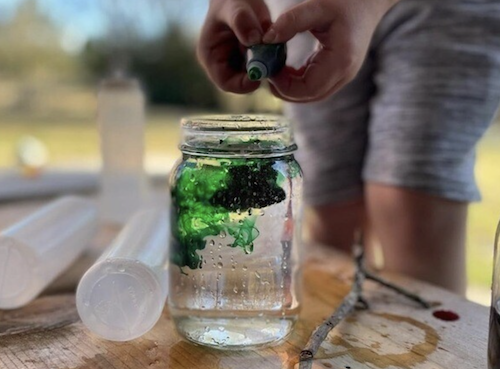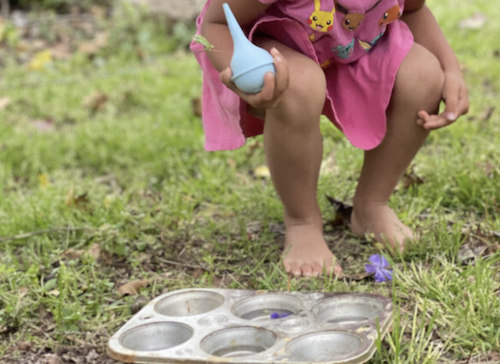Be a Bee
-
Age: 0 to 8+
-
Time: 1 hour+
-
Materials: pipette/turkey baster/eye dropper/spoon, jars or cups with water, colorful spices or food coloring, bowl or container
- Skills: Imagination, Gross Motor, Empathy
Bees play an important role in our ecosystem, pollinating plants and flowers and making more seeds, fruits, and foods that many creatures— including humans— depend on. In this activity, kids take on the perspective of hardworking bees as they collect “nectar” from pretend flowers and transport it back to the hive. As they play, kids will explore what bees might need to thrive and to do their important work.
The Guide
Step 1: Invite Play
Ask kids, “Would you like to pretend to be a bee?” Suggest that if they are going to pretend to be a bee, they’ll need some pretend flowers.
Step 2: Prepare your “flowers” and “hive”.
- Talk together about what bees collect from the flowers (pollen and nectar). Take out your jars/containers and suggest that you could use them to make pretend flowers to hold nectar for the bees.
- Fill your jars/containers about halfway with water. If you would like, enjoy adding drops of food coloring or colorful spices to create nectar for colorful pretend flowers. (Optional: Before adding the water, wet the lip of the jar with a bit of water and dip it into turmeric, dirt or flour to create a rim of pretend pollen).
- Grab a bowl or large container and suggest that this could be the pretend hive.
Step 3: Place your “flowers” and introduce a tool.
- Work together to place your pretend flowers around your outdoor space. Space them out if you can (bees often travel long distances to find flowers).
- Place your “hive” bowl somewhere in your outdoor space, too.
- Let kids know that just like bees use their straw-shaped mouths to collect nectar and bring it back to the hive, kids can use a special tool to collect their pretend nectar. Introduce your tool (e.g. pipette, turkey baster, eye dropper, spoon) and show kids how it works.
Step 4: Play like bees!
Invite kids to buzz from flower to flower, collecting nectar from the jars and bringing it back to their hive. As your little bee transfers nectar to the hive, welcome them to do a bee waggle dance to let other bees know where they can find flowers.
Extend the Play!
- Fan the Hive—Offer pieces of fabric or paper folded fans like these as pretend wings and welcome kids to fan the hive to keep it cool for the colony.
- Bee Wings—To give pretend play a boost, use fabric or paper to make bee wings. See how here.
- Save the Dandelions—Make dandelion inspired art to help kids remind themselves and others of how important dandelions are to our friends the bees. Read the full Save the Dandelions (and the Bees) DIY activity here.
- Water Fountain for Bees—Want another way to get kids involved in caring for our pollinating friends? Read how to make a water fountain for bees here.
Why is this activity great for kids?
Taking on the perspective of bees and thinking about how hard they work to carry out their important role supports the development of cognitive empathy. Exploring the give-and-take of pollination in playful ways helps kids sense how interconnected all living things are and how each of us can make a difference. Pretending to be busy bees also activates kids' creativity and cognitive flexibility. As kids work with pipettes/spoons to transfer water, bit by bit, to the hive, they build fine motor skills and practice persistence.





